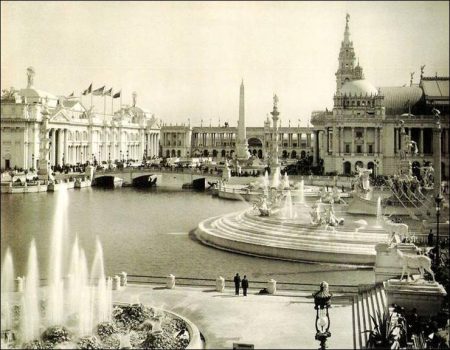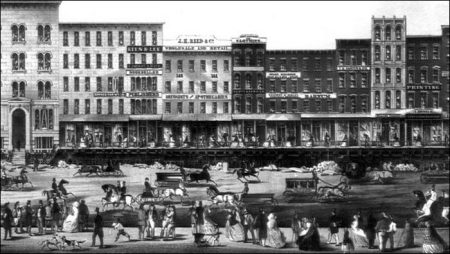In September 1673, there were seven Frenchmen here, but only for a day–Louis Jolliet, Father Jacques Marquette and five canoemen–first white men known to have been at the site of Chicago. Returning to Mackinac after exploring the Mississippi as a possible route to the Pacific, they had ascended the Illinois and Des Plaines Rivers, portaged across a short swampy tract in the southwest section of the present city, and paddled down the South Branch and the Chicago River into Michigan.
They had failed of their original quest, but they had discovered something quite as important–the Chicago portage, a principal key to the continent–and they immediately appreciated the value of their find. Jolliet envisaged a canal penetrating the heart of the immense expanse of New France, reporting that it would be necessary to dig through only “half a league of prairie,” to provide a continuous water route between the Great Lakes and the Mississippi Valley.
Curiously, no Indian settlement appears to have been made here until 1696 when Father Pinet, a Jesuit, established the Mission of the Guardian Angel and came periodically during the next four years to minister to the Miami, recent arrivals. The stream was known to the Indians as the Checagou, signifying anything big, strong, or powerful. But as the river was ever a small and sluggish stream, the “strong” probably referred to the pungent wild garlic that grew in profusion along its banks.
La Salle’s ambitious schemes to colonize the Illinois Valley failed; hostile Indians closed the Chicago portage for long periods. When possession of the entire region passed to the British in 1763, there remained in Chicago no permanent marks of the 90 years of French rule. Twenty years later the country became part of the infant American Republic, but actual control was exercised by the British and their redskin allies until they abandoned their posts following Jay’s Treaty, signed in 1794.
The next year, by the Treaty of Greenville, the Indians ceded, among other territories, “a piece of Land Six Miles Square at the mouth of the Chicago River,” recognized by the military authorities as a strategic point from which to command the farther reaches of the Northwest Territory, but no attempt was made to occupy it for almost a decade.
At length, in 1803, Capt. John Whistler, grandfather of the famous painter, arrived with a company of infantry from Detroit to take possession. At the point of a narrow bend in the river, which then curved sharply southward from where the Michigan Avenue bridge now stands, Whistler and his men built log blockhouses, barracks, and stores, enclosed within a strong stockade, and named the fort for Henry Dearborn, veteran of the Revolutionary War, then Secretary of War in Jefferson’s Cabinet.
Opposite the fort, on the north bank, stood four cabins; three were occupied by Frenchmen with their Indian or half-breed wives; the fourth, a large cabin of squared logs surrounded by numerous outbuildings, stood vacant. It had been erected about 1783 by Jean Baptiste Point Sable, an industrious and cultivated Negro of Santo Domingan origin, who had prospered in trading with the Indians and in outfitting occasional travelers using the portage, but who had suddenly vanished in 1800.
The Sable trading post was taken over in 1804 by John Kinzie, a Scotch-Canadian, the first English civilian settler, who in search of beaver pelts and shaved deerskins energetically extended his field of operation to the north and west. The settlement in the shadow of Fort Dearborn grew slowly until by 1812 it had a dozen or more small cabins sheltering some 40 persons–the Frenchmen and their families, the Kinzies, several farmers, a cattle dealer, and a few discharged soldiers with their families.
The War of 1812 aroused uneasy fears in this isolated outpost, especially after the news came that the British and their Indian allies had easily captured Mackinac at the head of the lake in July 1812. General William Hull, commander of the American forces in the Northwest, reported to the Secretary of War that he was ordering the evacuation of Fort Dearborn, “provided it can be effected with a greater prospect of safety than to remain,” but this conditional proviso was omitted in the order (not in Hull’s handwriting) sent to Capt. Nathan Heald, Whistler’s successor at the fort.
Black Partridge, a friendly Potawatomi chief, argued against removal, saying that he had been warned of trouble by “linden birds,” but on the morning of August 15, 1812, the fort was evacuated, and the group, numbering approximately 100, started south along the beach on their way to Fort Wayne, led by an experienced scout, Captain William Wells.
The nondescript column had not marched two miles when, with a whoop, a large band of Indians in their war paint came swarming down the dunes and fell upon the party, killing more than half–all of the dozen militiamen, twenty-six of the fifty-five regulars, two women, and most of the children. With the exception of the Kinzies, to whom the Indians were friendly, all survivors were taken and held captive until they were freed by ransom or death. The next day, the Potawatomi set fire to the fort in revenge for the many indignities the “Long Knives” had inflicted upon them in the past.
Four years elapsed before the fort was rebuilt. Kinzie and a few other survivors returned and some new settlers arrived. The growth of the powerful Astor’s American Fur Co. monopoly absorbed the individual traders and led, after lobbying in Congress, to the abolition of the government trading factory system in 1822. But the rapid decline of the fur trade in the depleted region had already set in.
Although an election was held in 1826 to select state and national officers, Chicago remained a somnolent settlement of squatters, evincing more vigorous signs of life only when the State Canal Commissioners surveyed and started the sale of a few blocks on both sides of the river as the terminal site of the projected Illinois-Michigan Canal. The date of the filing of the survey plat, Aug. 4, 1830, is the first in Chicago’s corporate history. The following year Chicago was designated as the seat of Cook County.
The enormous mushroom growth of the modern city began in 1833, the year Chicago was incorporated as a town with a population of less than 200. The surrounding area had been cleared of Indians by the removal of the tribes following the Black Hawk War, and a harbor was opened by cutting through the sand-bar from the bend in the river to the lake.
Glowing reports about the potential fruitfulness of northern Illinois and southern Wisconsin were eagerly received in the East–by farmers wearied of scratching the stony New England fields for an existence in competition with the more productive Ohio lands, discontented workers in the growing factories of New York and New England, and unsettled immigrants from western Europe in search of virgin soil on which to build new homes and an entire new life. The way was clear–the Erie Canal through the Mohawk pass to Buffalo, schooners and steamboats on the Lakes, and the harbor at Chicago.
Twenty thousand swept into Chicago from Buffalo in the first year ( 1833) of a wave that was years in passing. Many others came over eastern turnpikes. All but a few went on, in wagons, into the “plains without end.”
Realizing that Chicago’s marshy acres rested on economic bedrock, merchants early established the foundations for the vast trade to come. It was an era of wild speculation throughout the land-hungry country, but the fever raged nowhere more vehemently than in Chicago, climaxed in 1836 with the sale of lands along the projected Illinois and Michigan Canal. Harriet Martineau, in her Society in America, remarked amazement at finding in Chicago that “wild land on the banks of a canal, not yet even marked out” was selling for more than rich and improved lands “in the finest part of the valley of the Mohawk, on the banks of a canal which is already the medium of an almost inestimable amount of traffic.”
Incorporated as a city in 1837, Chicago suffered severely in the financial panic and deflation of that year, but on his arrival by steamboat the next summer, Joseph Jefferson, destined to become one of the great actors of his day, found Chicago in a typically buoyant mood: “Off we go ashore and walk through the busy little town, busy even then, people hurrying to and fro, frame buildings going up, board sidewalks going down, new hotels, new churches, new theaters, everything new. Saw and hammer–saw, saw, bang, bang–look out for the drays!–bright and muddy streets–gaudy-colored calicos–blue and red flannels and striped ticking hanging outside the dry-goods stores–bar-rooms–real-estate offices–attorneys-at-law–oceans of them!”
And he might have noted, but for his tender years, gamblers, horsethieves, holdup men, prostitutes, ruffians, and “rogues of every description, white, black, brown, and red,” the usual riffraff of a booming frontier town. To combat sin and discourage even innocent ribaldry, the more pious organized “seasons of prayer,” but with no appreciable effect.
It was the payment of eastern money for canal construction and harbor improvement that helped sustain the city until the flow of an agricultural surplus in 1841 from the rapidly developing surrounding region forced Chicago’s first rooted growth. From three States in a radius Of 250 miles, canvas-covered wagons, laden with wheat–200 a day by 1847–trundled prairie wealth into Chicago.
Elevators rose along the river banks, holding grain until the spring arrival of dozens of steamboats and propellors “and an almost endless number of large brigs and schooners,” from Buffalo. Half a million bushels in the second year of surplus ( 1842), 25 times as much a dozen years later, and Chicago became the world’s largest grain market. Hogs and cattle were driven through prairie grass to Chicago abattoirs; barreled pork and beef reached markets as far as London.
In 1847 there were more than 450 stores, centering mainly about Lake and Clark Streets. Lumber yards, elevators, shipyards, warehouses, and factories lined the docks of the river jammed with sail and steam craft.
Industry in the main was handmaiden to the extractive economy of the period. Field and forest fed tannery and packing plant, flour and wood-work mill; fabrications of farm machine works and wagon factories helped to cultivate and garner. But a small surplus of manufactured goods produced by the more than 200 concerns began to find an eastern market.
Most of the 16,859 residents of 1847 lived in frame or “balloon” houses, painted white; successful business men built large houses, some of brick, in green squares on the North Side (now the Near North Side). Hotels and taverns housed hordes of travelers and unmarried residents and provided centers for town conviviality.
Visits: 118




